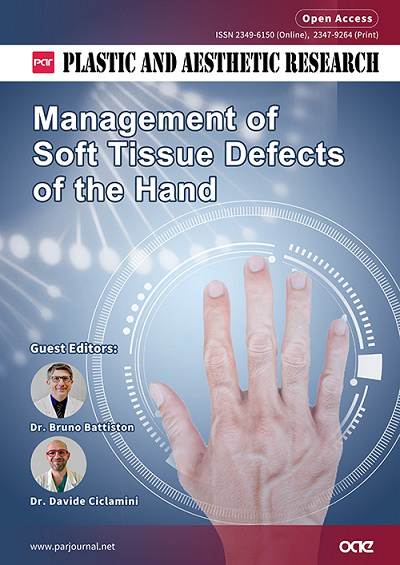
Topic: Management of Soft Tissue Defects of the Hand
A Special Issue of Plastic and Aesthetic Research
ISSN 2349-6150 (Online) 2347-9264 (Print)
Submission deadline: 15 Nov 2022
Guest Editor(s)
Dr. Bruno Battiston
Unit of Hand Surgery, Microsurgery and Reconstructive, Department of Orthopaedics and Traumatology, CTO Hospital, Turin, Italy.
Special Issue Introduction
The objectives of the reconstruction of soft tissue defects in the hand are to provide good soft tissue coverage to protect the vital structures, to allow the as soon as possible and as complete as a possible functional outcome, and to obtain an as good as possible esthetic outcome. Composite reconstructions refer mainly to defects created by severe trauma or for oncological or septic purposes. The high functional requirements of the hand with an intact osteoarticular structure depend not only on the skin coverage but also on the maintained function of tendons, vessels, and nerves. The new achievements in the research of skin blood supply and biological repair, together with the advances in reconstructive surgery, allowed the finding of a very large armamentarium of methods to solve this kind of defect. The skin of the palmar region differs from the dorsal one for thickness and flexibility, and it is important for the coverage of noble structures, while the dorsal skin is characterized by high mobility with respect to the underlying tissues to allow the complete flexion and extension of the fingers. The accurate reconstruction of the involved tissues and early mobilization are the cornerstones to restoring proper function. One of the aspects, which still spark a lot of discussions, is the right moment for the reconstruction: immediate or delayed, one or two stages. If a staged approach is deemed to be the best for the patient, the primary reconstruction should enhance and in no way compromise the secondary procedures.
This issue will focus on the type of defects (site, size, involved tissues), the timing of reconstruction, and the possible methods to be used, always considering the profile of the patient with his general clinical conditions.
This issue will focus on the type of defects (site, size, involved tissues), the timing of reconstruction, and the possible methods to be used, always considering the profile of the patient with his general clinical conditions.
Submission Deadline
15 Nov 2022
Submission Information
For Author Instructions, please refer to https://www.oaepublish.com/par/author_instructions
For Online Submission, please login at https://oaemesas.com/login?JournalId=par?IssueId=PAR220314
Submission Deadline: 15 Nov 2022
Contacts: Lilian Zhang, Assistant Editor, Lilian@parjournal.net





